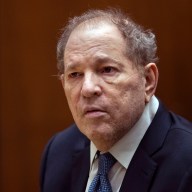 Derek Boogaard suffered a countless number of head injuries during his NHL career. He died in May 2011 at 28 years old of an accident painkiller overdose while recovering from a concussion.
Derek Boogaard suffered a countless number of head injuries during his NHL career. He died in May 2011 at 28 years old of an accident painkiller overdose while recovering from a concussion.
Credit: Getty Images
John Gallucci stood in front of the small amphitheater and stared hard at the small group that had come to hear him speak.
The medical coordinator for MLS and founder of the New Jersey-based JAG Physical Therapy, which counts the Red Bulls and the NHL’s Devils amongst its partners, wanted his words to resonate.
“We only have one brain,” Gallucci said during a symposium this weekend at the Yogi Berra Museum to discuss treatment of young athletes who suffer concussions with physical therapists and trainers.
Concussions have become as prevalent a topic in sports as wins and losses. Caused by head, face, neck or body contact and based, in part, on the velocity at the point of contact, there is no timetable for the cessation of symptoms. The accepted medical practice for someone who has suffered a concussion is physical and cognitive rest followed by ImPACT testing.
A short list of prominent New York athletes who have suffered concussions in recent years include Mets Ryan Church and Jason Bay, Jets quarterback Greg McElroy and Rangers defensemen Marc Staal and Michael Sauer. Jets receivers Al Toon and Wayne Chrebet and former Ranger Eric Lindros were forced to retire prematurely due to post-concussion symptoms.
Giants offensive tackle David Diehl, who joined Gallucci and Diana Toto, the program coordinator at Barnabas Health, recalled seeing teammates weep on the bench after suffering a concussion.
Those men were professional athletes who, in theory, received the best care possible. That is not always the case at the high school and youth levels.
“Not until high school,” Diehl said when asked the hypothetical question of whether he would allow a son to play football. “As a kid, your body is not fully matured. Your body is not ready to take that impact,” Diehl said. “Most importantly, [make] sure they’re coached the proper way — that the coach is teaching the way it should be done and not worried about losing football [games].”
Some of the decision making is being taken out of the hands of coaches at all levels. New Jersey is one of 48 states, along with the District of Columbia, that has student-athlete legislation on the books. South Carolina has pending legislation. Mississippi is the only state in the union that does not have either a law on the books or pending legislation.
The NFL has protocol mandating independent medical personnel in press boxes. Those “spotters” can call down to the sidelines and have a player removed from the game if it is believed the athlete suffered a concussion. Diehl reported that helmets are taken away from players on the sideline who may have a concussion in order to keep that player from returning to the field. The NHL implemented the so-called “quiet room” which allows team physicians to perform examinations on players suspected of having suffered a head injury.
Diehl commended referee enforcement of tightening chinstraps, explaining that a referee will tell a player once to tighten a chinstrap. If the player does not comply, he will be removed from the game.
“The NFL is spending millions of dollars to ensure the safety of their players,” Diehl said. “‘He got his bell rung.’ Those days are over.”
Still, there are concerns that professional sports teams may value wins over player safety. In a Week 3 game last season, Texans quarterback Matt Schaub absorbed an illegal helmet-to-helmet from Broncos linebacker Joe Mays. The force of the hit caused Schaub’s helmet to go flying and ripped off a piece of his left ear.
Schaub missed one play, and after the game told reporters he felt fine.
“Anytime you see a shot like that to the head, regardless if they’re not feeling the symptoms, it may take a little while for them to kick in. That’s where the NFL spotters and trainers have to step up and take away that warrior mentality away from an athlete,” Diehl said. “Any athlete is going to say, ‘Oh, I’m fine. I’m going to return to the game. This is the playoffs, win [and] go to the Super Bowl.’ We’ve seen the side effects. You would much rather trade sitting out that game than putting yourself in harm’s way.”
Tragically, there have been at least six deaths of major professional team sport athletes in the last three years where post-concussion symptoms either played a role or was a direct cause of death.
Derek Boogaard, Bob Probert, Dave Duerson and Junior Seau were diagnosed with chronic traumatic encephalopathy following post-mortem examinations. The families of Rick Rypien and Wade Belak have publicly stated the two hockey players struggled with depression.
Boogaard, Probert, Rypien and Belak were enforcers in the NHL. Duerson and Seau were Pro Bowlers at safety and linebacker, respectively. All were renowned for toughness.
Through its various broadcast partners, the NFL and NHL have celebrated violent hits and fights with replays and video clips, which seems to suggest a disconnect between the leagues stated goal of player safety.
“Everybody likes the excitement, the big hit,” Diehl said. “I’m going to hit a player as hard as I can, as fast I can, to the best of my ability. But I’m doing it smart. I’m seeing what I hit and most importantly, I’m not doing it in a cheap way. I’m doing it in a way that’s not only legal but it’s safe for both players. I’m not coming with my head down. You always have your head up.
“I watch our defensive players and our defensive staff — I’m seeing guys like Michael Strahan, guys who are in their eighth, ninth year in the NFL — going through during the first days of training camp or minicamp, [and] the fundamentals of tackling. Going through wrapping up, [with the] helmet to the side. That’s what needs to be enforced. That’s the thing we need to continue to promote. Have coaches learn these things.”
To that end, Hockey Canada has implemented a stringent rule banning head shots. Hockey Canada and USA Hockey have also banned body-checking at the peewee level.
“I’m in favor of anything that’s going to prevent a child from getting injured that doesn’t need to be injured,” Gallucci said. “So the component of changing rules in sports, if it’s for the safety of a child, I think it’s very important. I don’t believe everyone should be in bubble wrap. I think the component of the sport is important, but I think you can play youth sports, especially hockey, and not have to body check.
“The sport is skating, [it’s] finesse movement — [a] mechanical sport. Why do you have to slam somebody at 10 miles an hour into the boards just to stop him from maybe scoring?”
Barnabas provides cardiac and concussion screenings for athletes throughout New Jersey. Of the more than 4,000 screenings it has done, 13 percent of cardiac screenings “resulted in abnormal findings and recommended [a] follow-up with a pediatric cardiologist,” and 19 percent of those who underwent ImPACT testing “required post-injury testing and follow-up evaluation from their physician.”
Recently, the GyroStim machine has garnered interest for its treatment of patients with post-concussion symptoms, including Penguins center Sidney Crosby. A Denver Post story reported that the machine rotates a patient, who stares at a set point. The belief is that the neurological stimulation will help cure the patient of their concussion symptoms. However, the FDA has not given GyroStim its approval.
Follow Rangers beat writer Denis Gorman on Twitter @DenisGorman.















